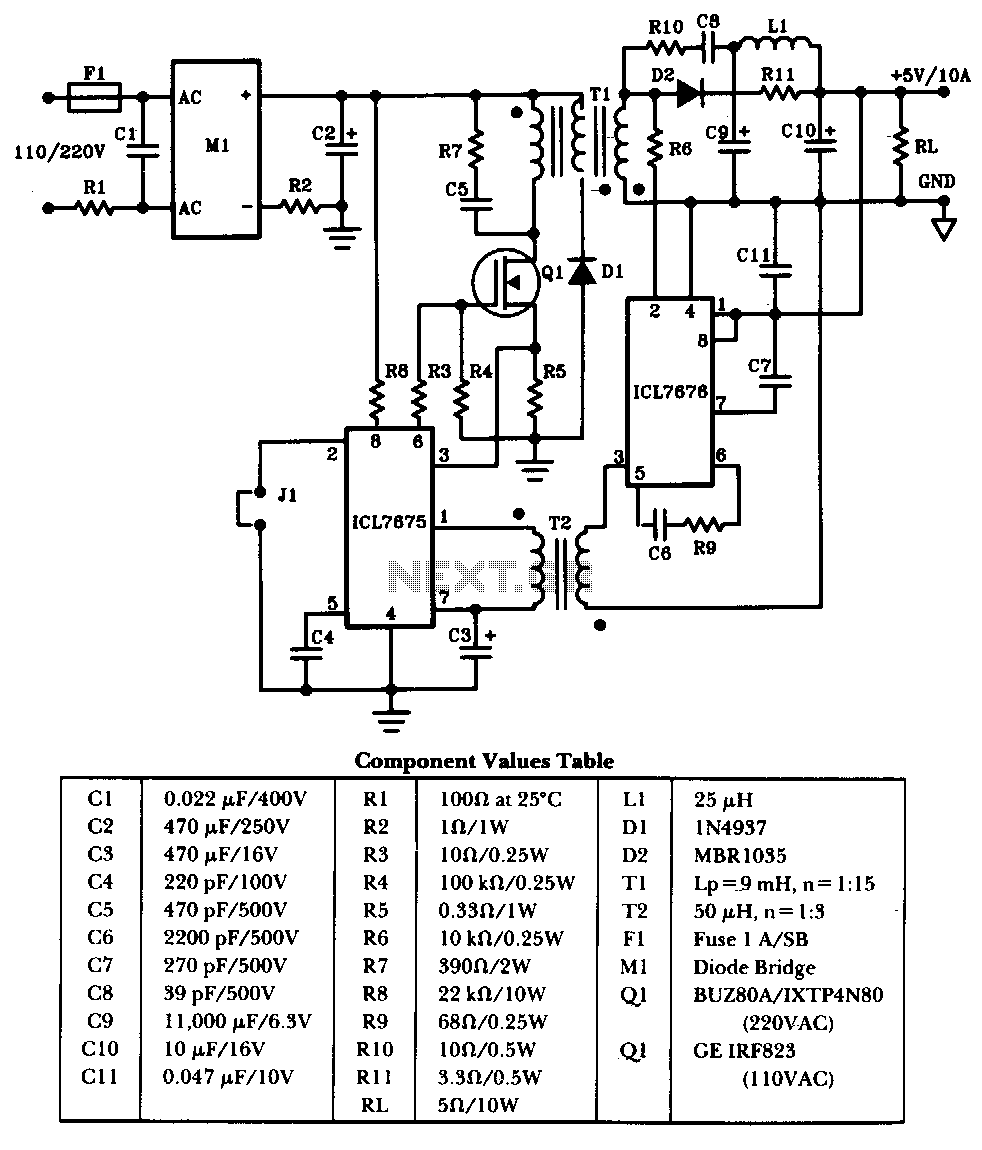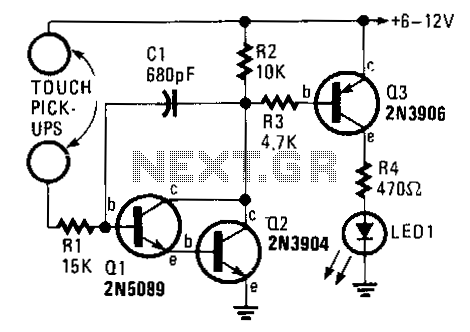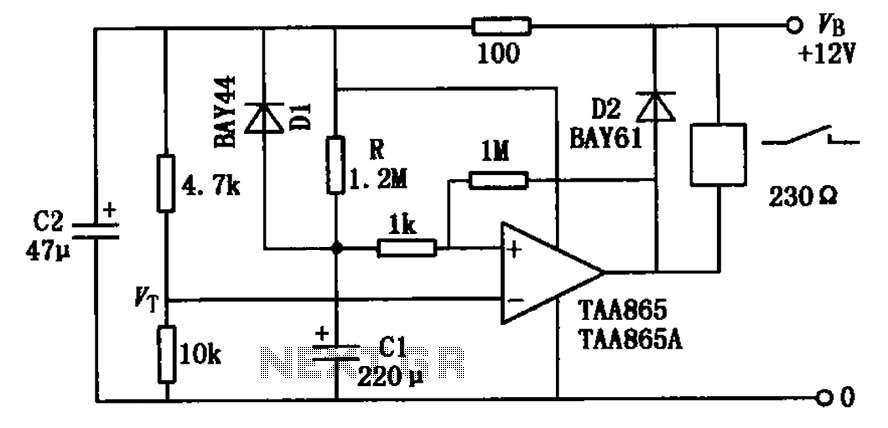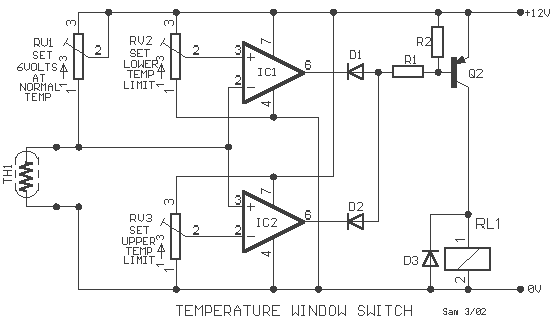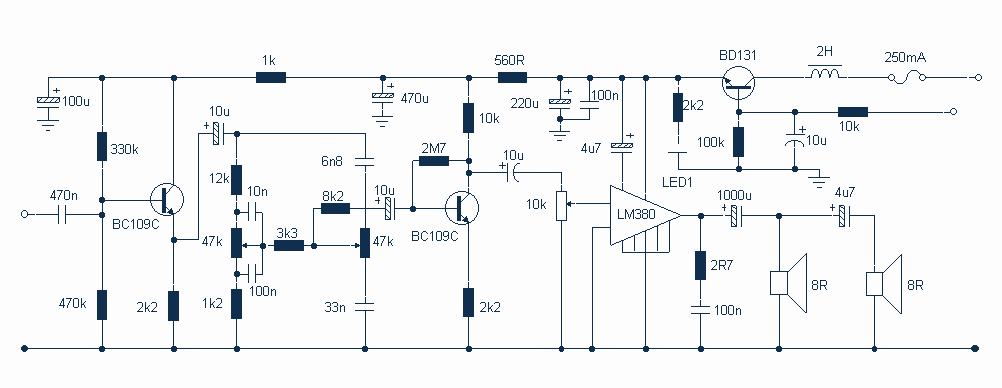
switch with relay schematic
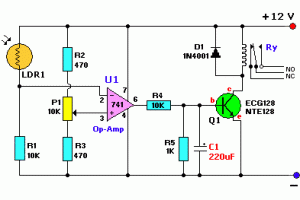
The Light Switch with Relay is a series of electronic switches that are controlled by light intensity. This circuit can automatically control lighting, turning the lights on when ambient light levels decrease. The threshold for light activation in the Light Relay Switch circuit can be adjusted using a potentiometer (P1), which sets the sensitivity of the light detection. The circuit utilizes a Light Dependent Resistor (LDR) as the light sensor, an IC 741 as a comparator and reference voltage sensor, and a relay driver transistor (Q1) that acts as an electronic switch. The Light Relay Switch circuit activates when the sensor does not detect light; to reverse this behavior (activating the switch when light is detected), the positions of the LDR and resistor R1 can be swapped. A diode (D1) is included to prevent electromagnetic interference (EMF) or sparking from the relay coil. The circuit is straightforward to construct and aims to provide a useful solution for controlled lighting.
The Light Switch with Relay circuit operates effectively by employing a Light Dependent Resistor (LDR) to sense ambient light levels. The LDR's resistance decreases as light intensity increases, allowing the circuit to respond dynamically to changes in illumination. The IC 741 serves as a critical component, functioning as a voltage comparator that compares the voltage across the LDR to a reference voltage set by the potentiometer P1. When the light level drops below a predetermined threshold, the output from the IC 741 changes state, triggering the transistor Q1. This transistor acts as a switch that energizes the relay, thereby turning on the connected lighting load.
The inclusion of the diode D1 is essential for protecting the circuit from voltage spikes caused by the relay coil's inductive load when it is de-energized. This protection is crucial in ensuring the longevity and reliability of the circuit components. The design flexibility allows for easy modification of the activation threshold by adjusting the potentiometer, making it suitable for various applications where automatic lighting control is desired.
Constructing the Light Switch with Relay circuit requires careful attention to the component specifications and proper assembly techniques to ensure functionality. The simplicity of the design, combined with its practical application, makes it an excellent project for both amateur and professional electronic engineers interested in automation and control systems. Overall, this circuit exemplifies a straightforward yet effective solution for enhancing energy efficiency and convenience in lighting control.Light Switch With Relay is a series of electronic switches that are controlled by a series of light received. Light Switch With Relay circuit can be used to control lighting automatically, so the lights can automatically turn on when the room light or the region began to decrease.
Limit of light used to activate the electronic switch in the circuit Light Relay Switch With This can be set via the potentiometer P1. P1 setting is basically a light reception sensitivity settings. Light Switch With Relay circuit uses the LDR as the light sensor and an IC 741 as a comparator and reference voltage sensor, relay driver transistor Q1 as as an electronic switch. A complete range of Light Switch With Relay is as follows. Circuit Light Relay Switch With diats a light switch that will be active when the sensor does not receive light, if you want to turn the tables (the active switch when the sensor receives light) it can be done by reversing the position between the LDR and R1.
Diodan D1 serves to avoid the effects of EMF or sparking of the relay coil. The circuit is simple and easy to make, I hope to provide ideas and descriptions in the manufacture of a controlled light switch. Hopefully useful. 🔗 External reference
The Light Switch with Relay circuit operates effectively by employing a Light Dependent Resistor (LDR) to sense ambient light levels. The LDR's resistance decreases as light intensity increases, allowing the circuit to respond dynamically to changes in illumination. The IC 741 serves as a critical component, functioning as a voltage comparator that compares the voltage across the LDR to a reference voltage set by the potentiometer P1. When the light level drops below a predetermined threshold, the output from the IC 741 changes state, triggering the transistor Q1. This transistor acts as a switch that energizes the relay, thereby turning on the connected lighting load.
The inclusion of the diode D1 is essential for protecting the circuit from voltage spikes caused by the relay coil's inductive load when it is de-energized. This protection is crucial in ensuring the longevity and reliability of the circuit components. The design flexibility allows for easy modification of the activation threshold by adjusting the potentiometer, making it suitable for various applications where automatic lighting control is desired.
Constructing the Light Switch with Relay circuit requires careful attention to the component specifications and proper assembly techniques to ensure functionality. The simplicity of the design, combined with its practical application, makes it an excellent project for both amateur and professional electronic engineers interested in automation and control systems. Overall, this circuit exemplifies a straightforward yet effective solution for enhancing energy efficiency and convenience in lighting control.Light Switch With Relay is a series of electronic switches that are controlled by a series of light received. Light Switch With Relay circuit can be used to control lighting automatically, so the lights can automatically turn on when the room light or the region began to decrease.
Limit of light used to activate the electronic switch in the circuit Light Relay Switch With This can be set via the potentiometer P1. P1 setting is basically a light reception sensitivity settings. Light Switch With Relay circuit uses the LDR as the light sensor and an IC 741 as a comparator and reference voltage sensor, relay driver transistor Q1 as as an electronic switch. A complete range of Light Switch With Relay is as follows. Circuit Light Relay Switch With diats a light switch that will be active when the sensor does not receive light, if you want to turn the tables (the active switch when the sensor receives light) it can be done by reversing the position between the LDR and R1.
Diodan D1 serves to avoid the effects of EMF or sparking of the relay coil. The circuit is simple and easy to make, I hope to provide ideas and descriptions in the manufacture of a controlled light switch. Hopefully useful. 🔗 External reference
